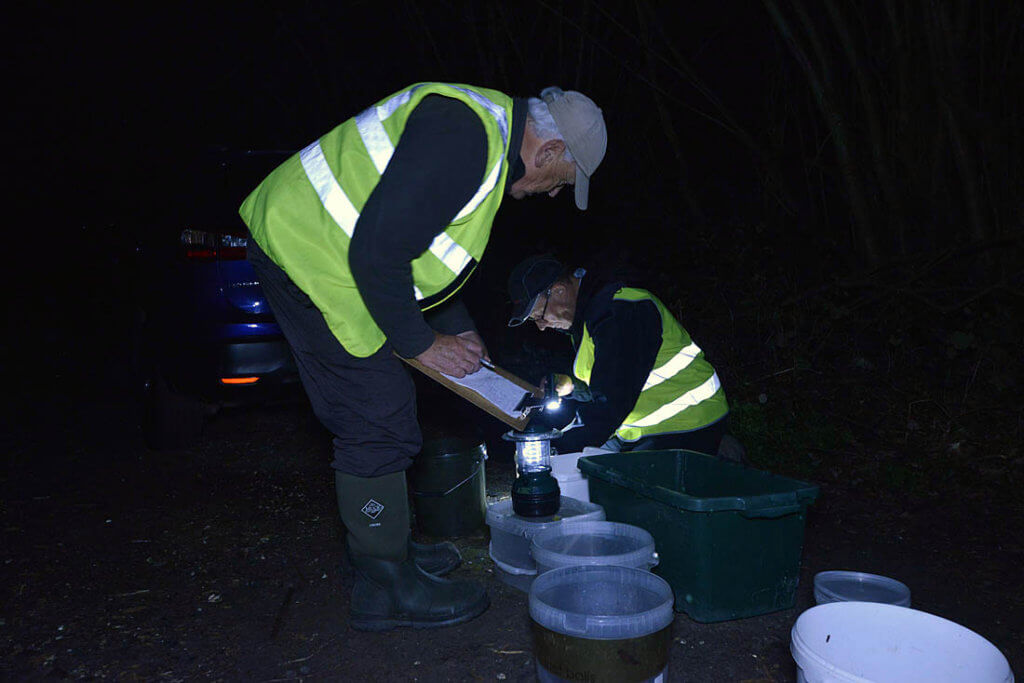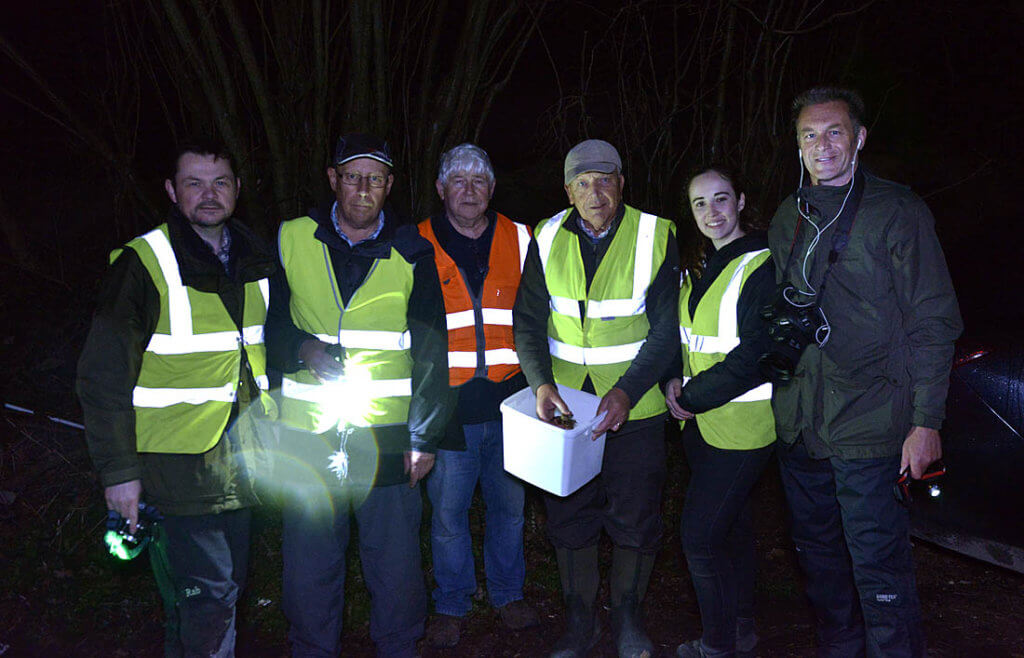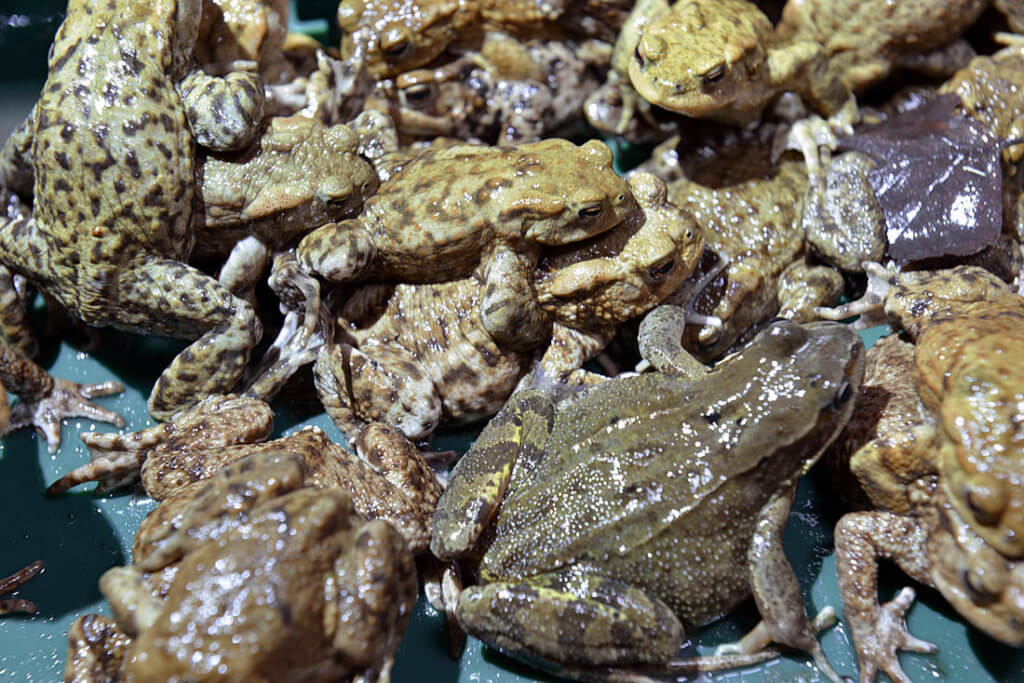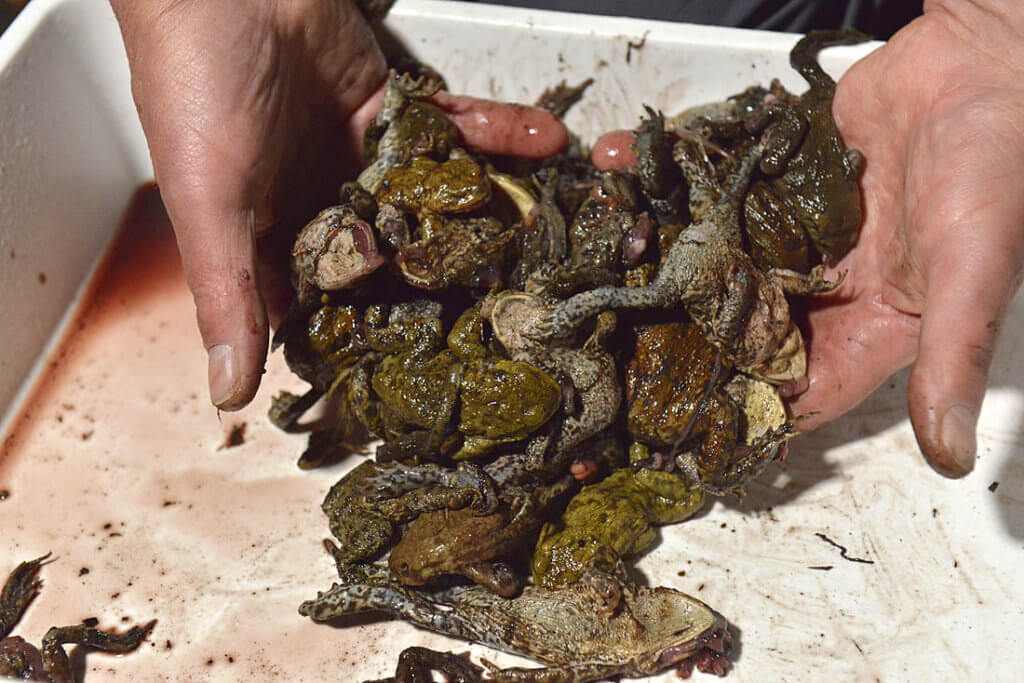This guest blog is an update to last week’s blog about carnage on a Hampshire road as passing cars kill passing toads, frogs and newts.

The rescue team at work: counting amphibia and moving them to safety. Photo: Rob Read – Nature Photographers Ltd.
In Hampshire, the run of mainly dry and chilly evenings continued until Friday night and for much of the week amphibian migration was relatively slow on Cufaude Lane. However, that changed on Saturday evening when temperatures rose and spots of rain were in the air. Thanks to the damp conditions, numbers of amphibians on that night equalled the cumulative total for the rest of the week. Since the last posting, the cumulative figures (25 February to 2 March) and the hours 18.00-21.00 are as follows: Common Toad – saved 246, killed 86; Common Frog – saved 23, killed 7; Smooth Newt – saved 28, killed 8. Until this week, only male toads had been noted. On Saturday, nearly a third that were saved were females, and 32 were in amplexus. The toad team has had to give up counting cars as it hampers their ability to save toads and other amphibians.

Toad patrol: Rob Read, Paul Sterry, Paul Beevers, Andrew Cleave, Megan McCubbin and Chris Packham. Photo: Rob Read – Nature Photographers Ltd.
On Saturday night (2 March) we were joined by Megan McCubbin, Chris Packham and Rob Read. In addition to saving toads (171 in total) and other amphibians, Megan and Chris were there to film the toad migration, and Rob was there to photograph the scene. Andrew Cleave was able to explain to them about the specific problems of Cufaude Lane, and Peter Gillatt of Hampshire and Isle of Wight Amphibian and Reptile Group (HIWARG) expanded on the bigger picture: the fact that the same thing is going on all over the country.
In the previous Toad Rage blog I alluded to the potential impacts of planning application 19/00018/OUT on the amphibians (and other wildlife) found in the vicinity of Cufaude Lane. Environmental surveys conducted on behalf of the developers Croudace Homes can be viewed on the Basingstoke and Deane Borough Council planning portal. For those with a botanical leaning, the surveys contain such illuminating insights as the presence of ‘thistle’ and ‘cranesbill’. Referring to my copy of Stace (the botanical Bible) I can see a dozen or more possibilities for the former, and 20 or so for the latter. So which species I wonder? Both taxa contain species that are far from common, after all. And for the ornithologists among you, the deskbound ‘search’ for notable species in the general area discovered what the survey refers to as ‘the Hobby Falcon’. If the development goes ahead and a primary school is built, perhaps the pupils could assist with similarly insightful environmental surveys in the future and help clarify the botanical points, assuming the species in question have not been concreted over of course. On a more serious note, the developers, and Borough and County councils, would get a better understanding of the problems and their solutions if advice was sought not only from individuals with local knowledge but also from informed organisations who care. The charity Froglife’s consultancy Froglife Ecological Services would be a good place to start.

Some of the lucky ones. Photo: Rob Read – Nature Photographers Ltd.
Thanks for the support and positive feedback from readers to the previous Toad Rage blog. As for the Borough and County councils, I’m afraid it has been a case of radio silence. Perhaps some of the councillors would like to join the toad patrol team on Cufaude Lane now that the nights are getting busy? They might just get a taste of what life’s like when you are a toad.

Carnage – just some of the casualties. Photo: Rob Read – Nature Photographers Ltd.
[registration_form]
I still remember the pond in the 1940’s where I first found and marvelled at the large number of newts living there, gone now of course. I remember the small yachting lake I discovered in the 1950’s which seemed to me to be seething with strange life forms, which vanished almost as soon as I came across it. The people living in the houses today where these oases existed would doubtless be concerned if an application were lodged to erect large numbers of houses near where they live, and are probably not aware of what was destroyed in order for their homes to be built. I don’t suppose there are many newts to be found there. The difficulty for the amphibians is, of course, that these lost habitats will never return, and the numbers of places they have remaining is always reducing, now to not much more than established reserves in many ares of the country, not linked to any other amphibian locations.
I wish that I could put forward a plan to stop progress, but the need for new housing is seen by most to be as great now as it was in the 1940’s. Trying to stop such ‘progress’ is a task beyond that which I am able to tackle. I hope that the toads on Cufaude Lane continue to try to survive for many years, and that a way is found to allow them to survive, as well as help all the reducing number places where amphibians can still be found. This is important local work.
Ah, the joys of reading reports written by ‘Ecological Consultancies’ for developers. My favourite remains. ‘Brown Trout. Flying south’ (a report signed off by the company’s CEO whose diligent oversight had failed to spot that the table’s columns were misaligned). Another was the claim that a wood was supposedly of little consequence due to an unremarkable avifauna yet the surveying claimed, without anyone at the company realising it’s import, and despite supposedly extensive ‘desktop research’, what would be a hitherto remarkably overlooked and regionally unique population of Marsh Tits and thereby, at a single stroke and no doubt far from the firm’s intentions, providing all the evidence needed to stop the development. Anyone who has gained competence in any area of wildlife identifications knows it takes a lot of effort and that’s it’s repeated experience that it key. Sadly a BSc or MA in a vaguely related subject is taken as ‘expert knowledge’ far too readily and unless there is someone at, say, the Local Authority who does genuinely have that expertise, and that’s often a matter of chance, or is at least prepared to find someone who does, these things just get the nod and go ahead.